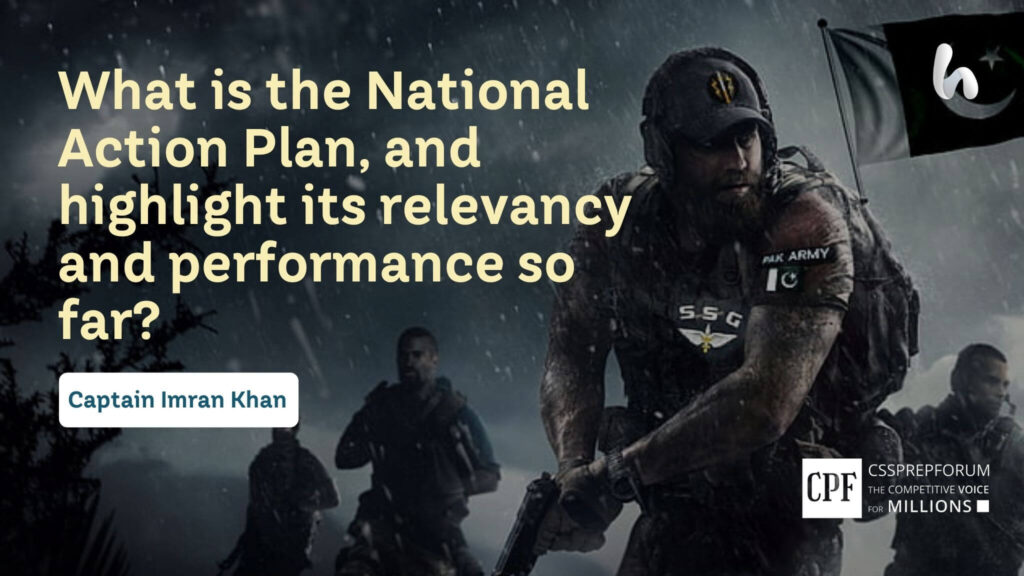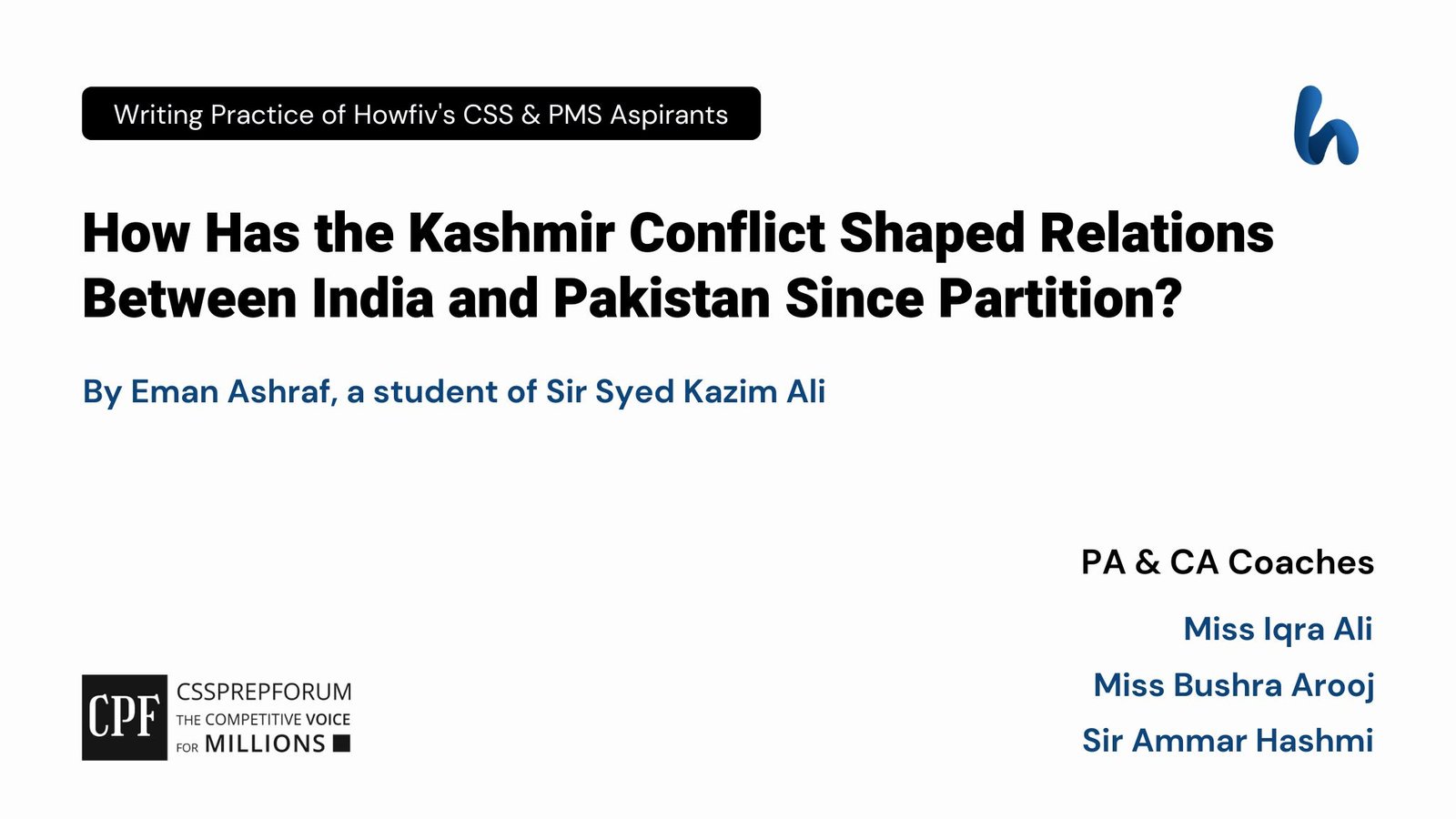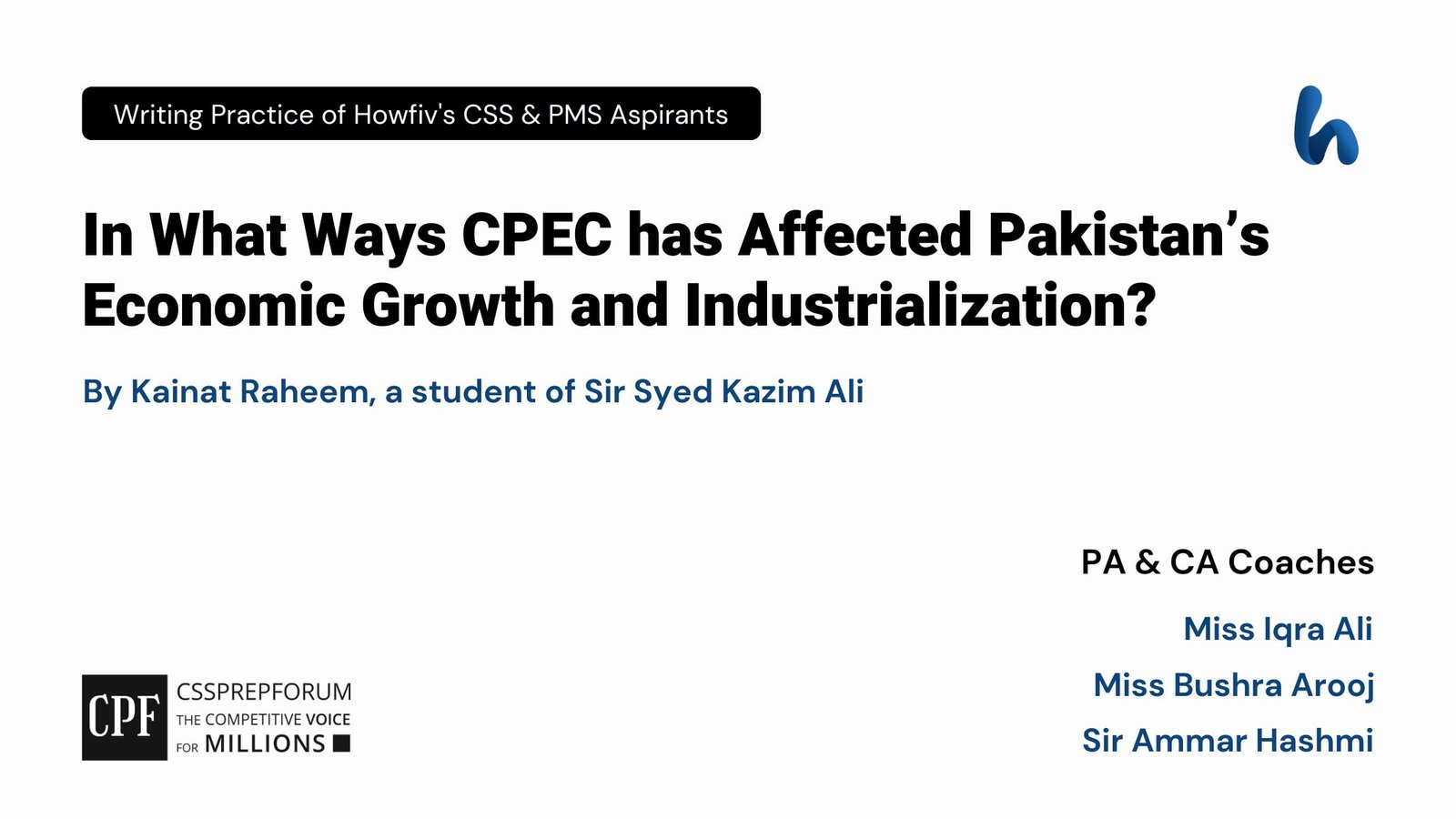The article is written by Captain Imran Khan, a student of Sir Syed Kazim Ali.

Nothing has challenged terrorism in Pakistan’s history the way the National Action Plan has done. It is one of those few national plans that were ostensibly designed with the consent of all political parties and the military. Although the policy has first been proposed to tackle extremist activities in reaction to 133 children being murdered in the terror attack of 2014, it has also paved the way for the economic development of the country through the provision of a safe business environment, thus, playing its role in its full potential. During the evolution of the contours of NAP, Mohammad Ali Babakhel- a renowned PSP officer and an authoritative author- said, “with political ownership, clarity, better civil-military understanding, coordination, and public support, we (Pakistan) may effectively respond to the challenge and convert it into an opportunity for structural readjustment.” However, political divisions, lethal workforces, overpowering behaviour of the military, and lack of innovation have started exploiting the true essence of NAP. In a very short time, the project has been started looking far more like a hastily-conceived documented plan devised during a moment of crisis than a coherent strategy. Consequently, many significant goals of the policy have remained unattended. Additionally, its policies could not withstand the changing nature of extremist activities after a certain time. For this reason, Pakistan is still facing unbridled massacres and killings, creating a fearful image of Pakistan all over the world. Hence, it is high time NAP be revamped according to the contemporary evolved refugees’ settlement issues, ethnoreligious polarization, and cyber-attacks in Pakistan. Further, governmental and political concerns need to be based solely on the country’s reform- not on their vested interests- so that the successful implementation of NAP could be ensured in eradicating the rampant social evils from the land of the pure.
Historically, Pakistan has faced unbridled terrorist attacks for a very long time. Many people were killed in the name of religion and ethnicity. However, no one paid heed until 133 innocent children lost their precious life in the hands of seven heavily armed terrorists at Army Public School Peshawar. The gloomy day was 16 December 2014. After the APS Attack, a national-level consensus evolved to harden down terrorism. Previously, the then PM Nawaz Sharif came into power. The government at that time started working on devising a National Internal Security Policy (NISP) – in 2014 to counter the prevailed challenges of threatened internal security. Due to the 9/11 terrorist attack, Islamophobia was also in the talk those days. Further, the FATA conundrum had added fuel to the fire. Hitherto, the APS massacre happened, which changed the political and governmental perspective and led to the formation of the National Action Plan.
Basically, National Action Plan is a comprehensive document that contains a set of policies with ideal steps to rid Pakistan of the menace of terrorism and militancy. For this purpose, the Parliament passed a bill containing the 21st Amendment Bill 2015 and Pakistan Army (Amendment) Bill 2015. Additionally, a twenty-point agenda for counter-terrorism, extremism, and sectarianism was called out by NACTA/ MOI. The document was approved by Parliament on 24 December 2014. Last but not least, NAP spelt out the specifics for the counter-terrorism drive in the country. The then PM directed Ministry of Interior to devise and implement a national monitoring mechanism, which curbed the scenario of terrorism at that time. The government has also involved several Federal Ministers, Provincial governments, and the military in preparing a comprehensive plan. Simultaneously, National Counter Terrorism Authority (NACTA) was assigned the role of monitoring body of the NAP. Within NACTA, Director CVE was entrusted with the monitoring of NAP. Thus, the act of mutual consensus for devising such a plan was a big achievement for the then government.
The twenty-point agenda of the policy covers the areas ranging from policymaking to execution in different manners and also enlists reforms for FATA and Afghan refugees’ issues. For instance, the military has been assigned to establish military courts for the time trials of convicted terrorists without any fear and pressure. Similarly, the Print media regulations and refrain from spreading hate speech in the country have also been regulated through this comprehensive plan. A task has also been assigned to the executives to regularize the seminaries. Similarly, military and Para-military operations against terrorists in full-blown were also assigned to security institutions, and this planning covers the whole country. Lastly, reforms in FATA were considered immediately for a better future and an organized plan for Afghan refugees, either in the form of registration or departure to their own country. Moreover, a detailed document mentioned the twenty-point agenda and responsible departments.
The performance of the NAP has been satisfactory as far as implantation and overall rules and regulations are concerned. It was a national level consensually and constitutionally approved document to deal with the extremism and terrorism in the country. All political parties have prepared all plans with the mutual consensus of civil government and military bureaucracy. Similarly, the military has been assigned the task to establish the courts for timely persecution of trials for those involved in terrorism cases. These courts run the cases and have sentenced forty-six terrorists. Furthermore, law enforcement agencies have also been tasked to regulate seminaries, terrorist networks, and their financing. To chock terrorist financing, 322 arrests have been made, and 214 Hawala-Hundi cases were also registered for the time being. Some money has also been recovered from illegal transactions, but Law Enforcement Agencies (LEAs) have not traced back the source or organization behind the said act. Thus, these leading elements have left no option for the terrorists but to quit.
For the accountability of scoundrels, NAP has also mentioned a full-fledged regulation for social media and considering reforms for the Federal Administrative Tribal Areas (FATA). The crackdown on social media includes hate speeches by the influencers on social media, in print media magazines and newspapers- and glorification of terrorism act both in newspapers and on social media. As for as our system is concerned, police have been given the task to identify hate speech and take action against them, while police officers only ban and close those shops and publication units, which only sell the material showing guns on their cover pages. They have never been quant with the proper education on how to identify hate speech. Second, a counter-terrorism force was sanctioned to fight against terrorism internationally.

Search, and cordon operations have been on the rise at those days, and they succeeded in arresting thousands of terrorists in all provinces, including Islamabad Capital Territory (ICT). Third, working on FATA reforms has started to prepare a plan for these backward areas. This aim was achieved after four years, but there were still quite a few developments after the FATA merger. Thus, major developments to curb the security crisis were achieved, but there is always institutional deformity for any fresh plan during implementation in Pakistan.
Three out of twenty points of the NAP state that militant outfits would not be allowed to operate in the country and strict actions would be taken against elements involved in spreading extremism. However, the recent announcements and activities taken by the government seem to have forgotten it all. The revocation of the Tehreek-i-Labbaik Pakistan’s (TLP) proscribed status and declaring a complete ceasefire with the banned Tehreek-i-Taliban Pakistan (TTP) has put a big question mark on the relevance of NAP. It should not be forgotten that government officials have repeatedly stated that both TLP and TTP are supported and funded by agencies like India’s Research and Analysis Wing (RAW) and Afghanistan’s National Directorate of Security. Similarly, hundreds and thousands of civilians and military personnel have laid their lives owing to the menace of extremism and terrorism in the country. Meanwhile, the tragic incident of the murder of a Sri Lankan national in Sialkot was another drawback of how radicalism and extremism have entrenched themselves in society. After the said incident, the government was not left with any action but to apologize on behalf of the whole nation. Further, the recent cyber-attacks on the Federal Board of Revenue’s (FBR) system, K-electric, and the National Bank of Pakistan (NBP) have also shattered the security of Pakistan. All the incidents mark a question in the relevance of NAP. Nonetheless, the statements of some ministers and the relevance of policy were simply pathetic as for as the response is concerned. The government had portrayed the state as merely defensive after these acts of challenging the state’s writ. Thus, it shows that NAP is relevant; its implementation is not applied at the execution end for the country’s integrity, Pakistan.
After the establishment of NAP through a constitutional amendment, government officials had started dis-owning the policy. The Interior Ministers had stopped mentioning the role and progress of NAP in the annual report. Similarly, the military had already been involved in the whole process, as well as the war on terror was been on the rise, and the military courts were also running by them for the trials of hard-core terrorists. Due to this reason, the military occupied the ground of owning the policy and started implementing it. Furthermore, civilians and judges started criticizing the military courts for awarding death sentences to the terrorists, for Supreme Court (SC) had refrained military courts from the execution of death sentences being announced. The main civilian department- police- had also been side-lined due to the over-involvement of the military. Surging dysfunctional mechanisms to assess the counter-terrorism effectiveness had also impacted the proper functioning of NAP. Additionally, the plan lacked explication, details, and innovation. Thus, the above-mentioned major challenges had been a hurdle as far as the implementation of the policy was concerned.
Although the circumstances have been vile, NAP still has the potential to tackle the threats of terrorism if a few steps are followed:
- The government and MOI are to deepen their concerns about administrating NAP.
- The overruling powers of the establishment are to be abated, and a consensus is to be developed between the military and civilian courts.
- The policies are to be made accordingly.
- The NAP needs to be innovated. For this purpose, it should be advanced with intelligence-based technologies according to the needs of evolving circumstances.
- Media talks and seminars are to be conducted for public awareness.
- The report on NAP effectiveness is to be published annually so that administration could keep a check on the plan’s efficiency.
The national-level consensually approved document has been one of the biggest achievements of Pakistan’s politically, ethnically, and religiously divided country. As far as preparing the document and devising the policy is concerned, it is a document that has been haltingly developed without rational thought and due deliberation in Parliament. NAP portrays an emotional reaction to curb terrorism after the APS attack. As for the country’s needs, the plan has not substituted Pakistan’s requirement for a comprehensive terrorism policy. Moreover, the policy was ad-hoc and has not provided a long and durable solution to the menace of terrorism. Although the country has somehow reduced terrorism due to the plan, it has not met the criteria to root-out the terrorism. Nevertheless, the significance of the NAP in the fight against terrorism has remained undisputed. Thus, the NAP is a positive step but not a whole package to counter the deeply rooted problem of terrorism in the country,
Conclusively, the massacre at the Army Public School, Peshawar, led to the formation of the National Action Plan (NAP). The NAP has exhibited an unparalleled national consensus to find a solution unanimously to eradicate bad evils, which severely impacted the very fabric of society. However, the plan has also some serious problems. It has put almost all the burden on the military. Further, it has side-lined the civilian forces and courts from any kind of extremists penalty. Despite all the errs and failures, it paved the way for the revised internal security policies that are considered a massive breakthrough in a shift towards a softer counter-terrorism approach, ensuring national cohesion and internal security in changing world. Therefore, NAP has been a basis for eradicating terrorism and extremism from the country. It has served the country in the hard times of surging terrorism and evolved to the form of NSP – a broad perspective. In short, NAP has the potential to curb many social evils from society if it is run with the same zest and unity as the way it was made.
Want to read CSS Pakistan Affairs Solved Past Papers and learn how to attempt them to score high? Let’s click on the link below to read them all freely. All past papers’ questions have been attempted by Sir Kazim’s students, who scored the highest in the subject.
CSS Solved Pakistan Affairs

More Essays
Click on any to start reading the essay.
Want to read General Science & Ability Solved Past Papers to learn how to attempt them to score high? Let’s click on the link below to read them all freely. All past papers have been solved by Miss Iqra Ali & Dr Nishat Baloch, Pakistan’s top CSS GSA coach having the highest score of their students.
Articles Might Interest You!
The following are some of the most important articles for CSS and PMS aspirants. Click on any to start reading.












